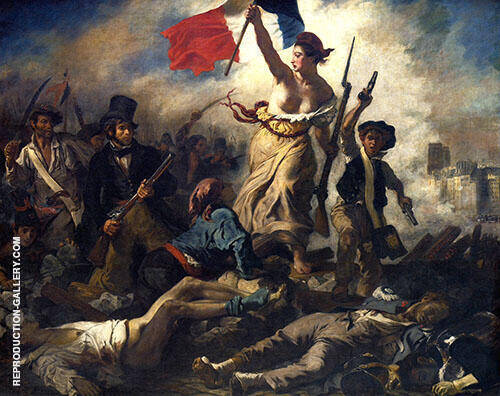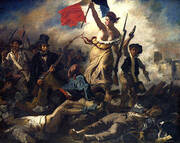Liberty Leading the People 1830 By Eugene Delacroix
Eugene Delacroix Liberty Leading the People
Delacroix Liberty Leading the People represents the July Revolution that swept across France. It’s one of art history’s most recognizable and radical images and cemented Delacroix’s reputation as a painter of the people.
What does Liberty Leading the People tell us?
Otherwise known as the “three glorious days,” this transformative uprising overthrew King Charles X. The revolution represented the shift from the House of Bourbon to the House of Orléans. It consequently marked the start of popular sovereignty replacing hereditary monarchical rights. Delacroix himself warmly celebrated these developments.
Among Eugene Delacroix paintings, Liberty Leading the People is unusual for its direct political and patriotic message. The famous woman in the center wears a “Phrygian cap,” symbolic of freedom for the French people. Waving the French tricolor flag, she stands for the best qualities of liberté, égalité, and fraternité.
However, a prominent feature in the painting, the tricolor flag, only became France’s national emblem after these events. Intriguingly, a second smaller tricolor is just discernible, fluttering from the towers of Notre-Dame cathedral in the background.
Is Delacroix's painting patriotic?
Liberty Leading the People is a prime example of a patriotic painting. Delacroix enhanced the partisan message by choosing individuals in the crowd below. Comprising workers, children, students, fighters, and even the upper classes, the diverse group represents the universal consequences of the French revolution.
The upper classes are identifiable through the man in a top hat, the student by a traditional bicorne, and the revolutionary worker recognizable as the young boy holding pistols. What unites all these figures, though, is their fierce determination for freedom. Likely borrowed from a print by Nicolas Charlet (an illustrator Delacroix particularly admired for his energetic and realistic compositions), their exact identities are topics of lively debate.
With plenty of guns, swords, and corpses scattered amongst the chaotic urban scene, it is no simple, revolutionary celebration. But, on the contrary, the French populace's heavy price is clear.
Delacroix wrote to his brother about the painting, describing it as a “modern subject.” Although he regretted not personally fighting for his country, he nonetheless said, “at least I shall have painted for her.”
Is Liberty Leading the People an example of romanticism art?
Liberty Leading the People exemplifies Romanticism painting characteristics. As a movement rejecting logical details and precise drawing, it contrastingly focused on emotional responses to modern events. In Delacroix’s painting, the woman symbolizes liberty, individuality, and the French republic itself. Reflecting Romantic sensibilities, she rises barefoot and bare-chested from the rubble.
Many scholars accordingly identify Delacroix’s work as the end of the Age of the Enlightenment, characterized by classical styles and academic certainty. Delacroix instead harks the beginning of the new Romantic era.
Sympathetic to the ideals of the French Revolution, early Romantics saw themselves as cultural revolutionaries. They fought with their pens and paintbrushes for intuition and emotion over capitalist industrialization. Indeed, the notorious Romantic poet Lord Byron inspired other Eugene Delacroix paintings (for instance, the Death of Sardanapalus).
Initially considered a dangerous and incendiary artwork, the French government removed the painting from public view. It was simply too political. Despite this, Delacroix's masterpiece returned to public display after the subsequent revolution of 1848 (which saw Louis Philippe, Duke of Orléans, deposed). It remains on view at the Louvre museum in Paris to this day.
The painting has subsequently inspired great works of literature, such as Victor Hugo’s Les Misérables, published in 1862.
We offer a 100% money back guarantee or replacement service. If for any reason you are dissatisfied with your painting please contact us within 7 days of receipt, advising the reason you are unhappy and we will provide you with all the information you need for its return or replacement.
We ship free to anywhere in the world via FedEx or DHL expedited service with online tracking.
Your painting will be shipped rolled in strong plastic tubing, ready for stretching and/or framing locally. This is the conventional method of transporting hand-painted oil on canvas. Learn more about how your painting is shipped.
We are able to offer a framing service intercontinental U.S. Please contact us if you would like a quotation. Alternatively, should you prefer, we can recommend a framer in your area.
Notes About Your Painting
Please note that replica oil paintings are finished with an additional 10cm (4") of extra canvas on all sides, allowing ample surplus canvas for stretching and framing.
Recently Viewed:
Cannot Find What You Are Looking For?
Reproduction Gallery Information
Customer Service
(Send Us A Message)
Tel: (503) 937 2010
Fax: (503) 937 2011







